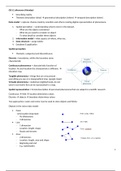Samenvatting
Summary GRS-10306 introduction geo-information science 20/21
- Instelling
- Wageningen University (WUR)
A summary of GRS-10306 introduction geo-information science, it includes all the content of the lectures, modules and the reader.
[Meer zien]





